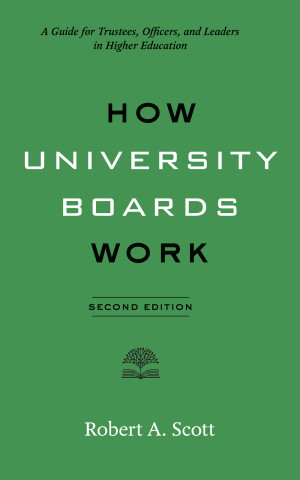
Reviews
As one of the most successful US college presidents in recent years, Robert Scott fully understands the importance of creating strong boards whose members understand the idiosyncrasies of academic institutions. Especially during these times when higher education is under assault from multiple directions, How University Boards Work should now be the first item in every new trustee's orientation packet.
Scott has written a gold standard owner's manual for college and university board members. Bob Scott is the Julia Child of higher-education governance.
The college invited me. I was flattered. I accepted. What have I gotten myself into? This book has the answers. Robert A. Scott's How University Boards Work is both profoundly intelligent and readable.
As I saw while serving as a trustee of Adelphi University, Bob Scott was transformational and is one of the most capable university presidents I know. I am glad he has written this important book.
I strongly recommend Bob's book. It should be required reading for all boards and presidents. I've used it with my own board to great effect. A well-informed and effective board is essential for the future of our institutions, particularly in today's challenging times.
Scott's insights and recommendations ring true to me based on my years working with boards at Yale, the University of Chicago, and The New School, as well as at the American Academy of Arts & Sciences. How University Boards Work is more than a 'how-to' guide. It begins with a thoughtful look at the history and mission of higher education that concludes with a discussion of future challenges. It is a vigorous call to action to recognize and protect the special role of higher education through the courageous and thoughtful leadership of boards of trustees.
Book Details
Table of Contents
PREFACE
ACKNOWLEDGEMENTS
Introduction: Why a Guide?
1. Historical and Structural Framework of Governance
2. Board Responsibilities
3. Board Membership
4. Processes and Procedures
5
Table of Contents
PREFACE
ACKNOWLEDGEMENTS
Introduction: Why a Guide?
1. Historical and Structural Framework of Governance
2. Board Responsibilities
3. Board Membership
4. Processes and Procedures
5. Strategic Leadership
6. Leading Higher Education into the Future
EXERCISES
APPENDIXES
A Performance Review of the President
B Orientation Packet
C Bylaws
D Board Meeting Agenda
E Confidential Periodic Report of the President
F Dean's Report
G Transition Memorandum
H Model Succession Planning Memorandum
NOTES
WORKS CITED
SUGGESTIONS FOR FURTHER READING
INDEX





